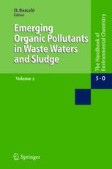Search
Search Results
-
NP, OP and Derivatives in Freshwater Sediment Downstream of Textile Associated Municipal Wastewater Discharges
Alkylphenol ethoxylates comprise of many anthropogenic chemicals such as nonylphenol (NP), octylphenol (OP) and nonylphenol ethoxylates (NPEOs). The...

-
Environmental contamination status with common ingredients of household and personal care products exhibiting endocrine-disrupting potential
The continuous use of household and personal care products (HPCPs) produces an immense amount of chemicals, such as parabens, bisphenols,...

-
Advanced Treatments for the Removal of Alkylphenols and Alkylphenol Polyethoxylates from Wastewater
Since the 2000s, among organic contaminants, alkylphenols and alkylphenol polyethoxylates have been listed as hazardous substances by several...
-
Nonylphenol, Octylphenol, and Nonylphenol Ethoxylates Dissemination in the Canadian Freshwater Environment
Nonylphenol, octylphenol, and nonylphenol ethoxylates are manmade compounds that are only discharged in the environment due to anthropogenic...

-
Removal of alkylphenols from industrial wastewater by means of ozone-based processes and fenton reaction
Alkylphenols belong to the group of synthetic specific substances and their effective removal requires non-traditional processes, novel approach and...

-
Occurrence and concentrations of organic micropollutants (OMPs) in highway stormwater: a comparative field study in Sweden
This study details the occurrence and concentrations of organic micropollutants (OMPs) in stormwater collected from a highway bridge catchment in...

-
Innovative technologies to remove alkylphenols from wastewater: a review
Alkylphenols and alkylphenol polyethoxylates are emerging hazardous contaminants due in particular to their endocrine-disrupting properties. These...

-
Nonylphenol ethoxylate degradation in detergents during shelf time, a new exposure pathway, and a perspective on their substitution
Detergents are highly produced pollutants with environmental problems like foam generation and toxic effects in biota. Nonylphenol ethoxylates (NPEs)...

-
Identification and Determination of Nonionic Surfactants by Ultrahigh-Performance Liquid Chromatography–High-Resolution Mass Spectrometry
AbstractWe proposed a procedure for the identification and determination of nonionic surfactants in natural waters by ultra-HPLC with high-resolution...

-
Co-formulant in a commercial fungicide product causes lethal and sub-lethal effects in bumble bees
Pollinators, particularly wild bees, are suffering declines across the globe, and pesticides are thought to be drivers of these declines. Research...

-
Occurrence of Xenoestrogen Alkylphenols (Octylphenols and Nonylphenol) and Its Impact on the Aquatic Ecosystem
The aquatic ecosystem is one of the most contaminated environments in the present scenario. Recently, the existence of endocrine-disrupting chemicals...
-
Deep Destruction of the Triton X-100 Nonionic Surfactant in Water by Advanced Oxidation Processes Involving Ozone
AbstractAlkylphenolpolyethoxylates whose bioresistant metabolites (alkylphenols, short-chain alkylphenolpolyethoxylates and alkylphenoxycarboxylic...

-
Physiological and Reproductive Disorders of Baltic Amphipods Gmelinoides fasciatus Exposed to 4-tert-Octylphenol
AbstractAlkylphenols, which are industrial chemicals, are xenoestrogens; however, their sublethal effects on aquatic animals are poorly studied. The...

-
Review on conductometric, volumetric and computational studies on surfactants-amino acids interactions
In this review amino acid-surfactant interactions mainly in aqueous solution has been explained. Amino acids and surfactants interactions are...

-
Hazardous Organic Chemicals in Biosolids Recycled as Soil Amendments
The generation and disposal of biosolids produced at municipal wastewater treatment plants is a major environmental issue. Approximately 900 kg of...
-
Environmental Impact on Bone Health
The skeleton forms a dynamic organ system, functioning in a highly metabolic environment continuously affecting the balance between bone resorption...
-
Role of Chemicals in Textile Processing and Its Alternatives
Chemical substances and additives have a crucial function in the manufacturing of textiles, starting from the elimination of impurities from fibers...
-
Experiences and consequences of phasing out substances of concern in a multinational healthcare company
BackgroundIn 2015, one of the largest healthcare companies in the world committed to phasing out from all its products and processes worldwide any...

-
Organic Compounds in Paper Mill Wastewaters
This chapter is focused on the problem caused by the effluent discharges from paper and pulp mills. At present, three aspects should be considered in...
-
Biodegradation of Crude Oil and Biodegradation of Surfactants
Biodegradation can occur in a range of conditions, and it has been discovered that a variety of substrates can be biodegraded. Mineralization, the...
